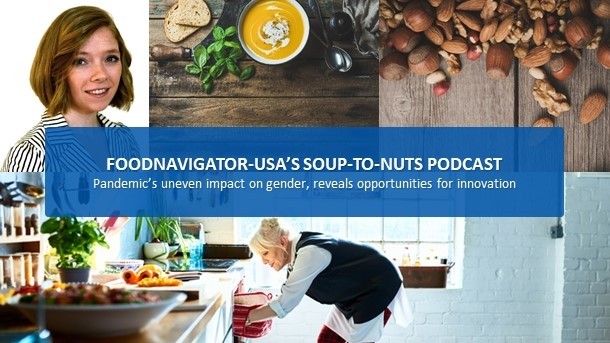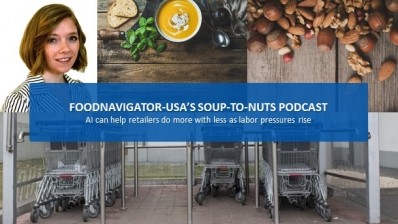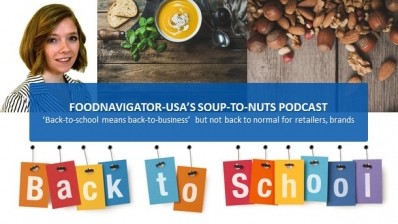Soup-To-Nuts Podcast: Pandemic’s uneven gender impact reveals opportunities for product development

According to Murphy Research’s recently released first quarter State of our Health report, while nearly all Americans stopped or dramatically reduced dining out during the peak of pandemic, only women actually cooked at home more. And, while there were desirable aspects, for the most part, women weren’t happy about it.
Sarah Marion, the cultural anthropologist who leads Murphy Research’s State of our Health report, explains that this insight could have an outsized impact on how food and beverage manufacturers innovate and market products going forward. For example, she explained, eating at home is expected to remain elevated even as pandemic restrictions ease, and many women will seek new solutions to help them reach a more sustainable and satisfying balance of healthy eating, saving time and variety. In this episode of FoodNavigator-USA’s Soup-To-Nuts podcast, Marion also shares how else the pandemic change consumers approach to food and nutrition, and which of these trends are here to stay and which likely won’t last.
[Editor’s note: Never miss an episode of FoodNavigator-USA’s Soup-To-Nuts podcast – subscribe today.]
The gender divide
With the goal of better understanding health and wellness in America, Murphy Research’s State of our Health study is based on quantitative and qualitative data collected monthly online from 1,000 people 13 years and older since 2018.
From this massive data set, Murphy Research was able to compare historical behavior patterns to those during the peak pandemic to reveal some surprising insights – among them is that while all Americans stopped dining out as frequently during the pandemic and ate more meals at home – 67% of women reported they cooked at home five or six nights a week in the first quarter of 2021 compared to 60% of men.
“The percentage of women who outsource meals in other ways never really changed very much. There was a little uptick in takeout among women in the fall of last year, but otherwise, very, very flat. So they didn’t actually fill that gap with other types of meal sourcing. What they did was cook at home more often,” Marion said. “And the interesting thing is that men didn’t.”
While cooking at home affords people more control over their diet and ostensibly the ability to select healthier options, Marion notes women were more likely than men to report that their diet became less healthy or their weight more difficult to manage during the pandemic. Women also were more likely than men to report more stress around food.
Broadly speaking, Marion said, this dynamic also is reflected in how women and men approach grocery shopping. She explains that just like women are more likely to cook, they are more likely to be the main grocery shopper and carry the heavier mental load of pleasing the family, planning for the future and balancing the budget.
“Whereas men take the grab-and-go approach,” and “don’t feel the same kind of need to compare all the brands,” she added.
That said, as it becomes safer and easier to eat at restaurants both men and women will take advantage of the variety and convenience they offer. However, Marion notes, because of the extra practice cooking many women gained during the pandemic they are more likely to continue to eat at home – reserving restaurants for more special occasions.
“We are seeing dining out increasing a little bit, but as you might expect its going up faster among men than women,” Marion said, explaining that for women who now have a larger range of meals they can prepare at home the cost-benefit ratio of eating out has restricted.
“The weeknight dinner where maybe two years ago you took everybody out to Red Robin or some kind of fast casual sit down because you didn’t have a plan for dinner. Now you have the things at hand and the skills and repertoire to whip something up for that Wednesday night meal,” she explained.
Marion also notes that both men and women living with children are more likely to say they want to continue eating at home more going forward – even though it can be more work.
Consumers need faster, easier at-home solutions
But that doesn’t mean most people will continue to cook from scratch as often as they did during the pandemic – especially women who have carried the bulk of the burden of meal prep and likely are on grappling with cooking fatigue.
Rather, Marion said, consumers likely will look for easier fully or partially prepared meal solutions at the grocery store – which is where the opportunity is for food and beverage brands to offer new solutions and earn loyalty.
“I suspect that people are not doing the Rachel Ray whip up dinner in 15 minutes. What they’re probably doing is a combination of things. Now they keep a stash of emergency meals on hand, which might be a frozen pizza, it might be a frozen bag meal thing and then you put together a side dish so itis half cooked half convenience,” she said.
On-the-go eating will rebound, but look different than pre-pandemic
As consumers continue to reemerge from lockdowns and either return to work, school and other in-person obligations, Marion predicts that on-the-go eating will rebound – but, she hypothesized, what consumer eat while out and about likely will look very different than what it was before the pandemic.
She explains that after 15 months of eating “real” food at home, consumers are less likely to settle for meal replacement bars and shakes – looking instead for convenient versions of what they might make for themselves at home if they had time.
“There is a gap between what people actually want and what they have time for, and so I think that brands that can deliver something that feels more like a meal, closer to that fulfilling meal, while still being a convenient replacement or offering portability,” such as an oatmeal cup or microwavable breakfast sandwich, “are well positioned for the future,” Marion said.
She added retailers can also benefit from this by offering a broader selection of prepared food or creating displays that feature easy meal solutions and on the go options that are more akin to what people would cook if they had time.
Any noticeable shift in on-the-go eating and the types of products consumers opt for likely will be delayed for the duration of summer – and kick in fully in the fall when schools re-open and many people who have worked remotely during the pandemic are scheduled to return to their offices.
And when it does happen, Marion said, many consumers may be at a loss about what to buy or open to try new products because the pandemic eroded many of the habits people had formed previous around on-the-go eating.
Ecommerce will continue to grow
The last big trend to emerge from the pandemic that Marion believes is here to stay is online shopping – which she explains offers convenience and time-savings that consumers will want as their lives become increasingly busy.
To take full advantage of this – and the other opportunities emerging from the pandemic, Marion says that retailers and brands need to make it just as easy for consumers to discover and purchase healthy, easy meal solutions online as in store. And they need to communicate across channels and platforms what they offer online and in store.
These insights are just a tiny fraction of Murphy Research’s findings in its State of our Health report. If you are interested in learning more, please visit: www.murphyresearch.com/state-of-our-health/overview.

















